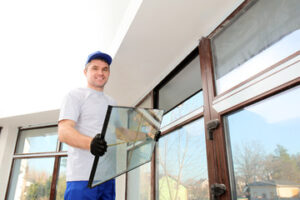Cracks and spalling can damage concrete’s appearance and suggest a serious structural problem. It’s worth pursuing repair procedures to preserve concrete structures and make them safe, secure, and durable.
Selecting repair materials requires considering their tensile strength, elastic modulus, thermal expansion and contraction coefficients, moisture transmission, and drying shrinkage characteristics. Contact Concrete Repair Dallas now!

Concrete is a rugged material that can withstand considerable wear and tear, but like all materials, it will eventually show signs of aging. The best way to extend the life of your concrete is to take proactive steps to prevent and address damage. This includes identifying current and potential problems and using proper concrete repair techniques for each situation.
The first step is to prepare the surface to apply your repair solution. This includes removing any existing coatings and assessing the condition of the concrete. This is a critical step because the quality of the existing concrete will impact the longevity of the repair. In addition to examining the concrete for signs of damage, it should be tested for soundness by tapping on it with a hammer or chain. If you can hear a solid rebound, this indicates that the concrete is still structurally sound.
Once the damaged area is identified, it should be cleaned thoroughly to remove dirt, oil or grease, and rust stains. It’s also important to check for any cracks or areas of concern, as these may need to be addressed by a professional contractor, such as epoxy injection, to ensure the integrity of the entire structure.
After cleaning, the concrete surface should be profiled to create an open texture that promotes a strong bond between the existing concrete and the repair material. The roughness required depends on the type of repair; ICRI has established guidelines, known as the Concrete Surface Profile (CSP) scale, that range from 1 (nearly flat) to 9 (extremely rough).
Once the concrete is profiled, it should be brought to a Saturated Surface Dry state (SSD). This is accomplished by lightly dampening the surface and allowing it to absorb without creating puddles or standing water. This state is necessary for a successful repair because it ensures that the concrete surface is not adding water to the repair material or absorbing water from the repair material, both of which can weaken its performance. For this reason, it’s essential to use a suitable water-based bonding agent when conditioning concrete surfaces prior to applying any repair material.
Renewal
Concrete is strong and durable but it can still be affected by a number of factors that result in structural damage. Building renewal techniques can be used to repair and upgrade these structures, enhancing their sustainability and safety for all users. These methods can help to save on long-term operating costs, improve safety and security, and even extend their useful life.
Some common signs that concrete needs repair include visible cracking, spalling, and discoloration of the surface. These problems can all lead to further deterioration of the concrete, and can potentially expose the rebar within the structure, leading to rust and corrosion. Water leaks and stains can also be a sign of damage, as these indicate moisture is entering the concrete and can exacerbate any existing issues.
The best way to deal with concrete deterioration is to prevent it from occurring in the first place. This is why regular inspections and moisture barriers are so important, as they can nip issues in the bud before they worsen.
Whether it’s a driveway, parking lot, or sidewalk, any type of concrete is subject to wear and tear over time. Rather than replacing these structures, concrete resurfacing can be a cost-effective alternative that restores the strength and appearance of the existing surface.
When properly executed, a concrete resurfacing can last for decades, and will save on costly replacement and maintenance costs. Resurfacing a concrete surface is typically done using a concrete overlay, which is applied over the existing concrete to create a brand new surface.
A special polyurethane foam is injected underneath the existing concrete and allowed to expand. This process is known as concrete lifting and can effectively repair cracks, spalling, and other damaged areas of the concrete surface.
Tar Heel’s proprietary method of concrete renewal uses a polyurethane foam injection system called PolyRenewal(tm). It is composed of two different compound liquids that are combined at the injection nozzle, then injected beneath the concrete surface. Once injected, the foam expands to about 15 times its initial volume, filling voids and lifting settled concrete quickly and effectively. PolyRenewal(tm) is also waterproof, and will not wash out or settle under concrete, unlike traditional solutions that can break down or leach into the soil.
Repair Materials
A good repair material is crucial in a concrete repair project. It needs to be compatible with the damaged structure and have the strength, elasticity, freeze-thaw resistance and abrasion resistance needed for the job. Many repair materials are available, including unmodified Portland cement mortar or grout, latex modified Portland cement mortar or concrete, quick setting non-shrink concrete, polymer concrete and epoxy compounds. Selecting the right repair materials for a particular job is a complex process that involves considering several factors, including cost, performance and ease of application.
Whether the repair material is being used on new or existing concrete, proper surface preparation is key to its success. Cleaning, profiling, saturating, priming and applying the correct level of surface roughness are all important steps in ensuring the bond between the old and new concrete is strong enough to withstand the stresses and strains of use and weathering.
The type of repair material will also play an important role in how well it bonds to the concrete substrate. The bond between the repair material and the concrete matrix is what keeps the repair material in place, allowing it to continue doing its job for as long as possible. A good quality, durable repair material should have low shrinkage so that it does not debond the concrete substrate and leave gaps in the surface.
Several mechanisms are involved in building a strong interfacial bond between the repair material and the concrete substrate, including increasing the roughness of the surface, adding fibers, using silane-based coupling agents on substrate surfaces or modifying cement-based repair materials with organic materials. Research has shown that the use of these methods improves the interfacial bond between the repair materials and the substrates, resulting in better mechanical, chemical and physical interaction between them.
Another key step in the repair process is the curing of the repaired area. This is a critical step that should not be shortened or performed haphazardly. Insufficient curing will result in short-term deterioration of the repairs and may require them to be replaced earlier than necessary. Insufficient curing also has a negative impact on the durability of the repaired area and can cause the repair to fail prematurely, requiring additional costs for replacement.
Curing
Concrete must be properly cured to develop the hard, resistant surface that we depend on for concrete driveways, sidewalks and foundations. Curing is a complex process that occurs at various depths within the concrete, giving it its strength and durability. Inadequate curing can lead to premature cracking, spalling and deterioration.
Providing sufficient moisture is essential to the proper curing of concrete. This can be done by ponding, spraying, covering the concrete with plastic sheeting or applying membrane-forming curing compounds. By preventing loss of mixing water, these methods allow the concrete to remain wet for extended periods of time, allowing it to hydrate properly.
The concrete must also be protected from excessive heat or cold during the curing process. Concrete will hydrate at a rate determined by its temperature and humidity. Optimal temperatures for curing are 50 degrees and above with 80-85% humidity. Concrete that is exposed to extreme heat or cold will take longer to cure and may have problems with shrinkage, porosity, strength and durability.
Other factors that can impact concrete curing are the water-to-cement ratio, mix design, temperature, air movement and placement conditions. Some concrete pourers use concrete curing accelerants like steam, heating coils or heated forms to speed up the hardening of concrete. However, these acceleration techniques must be used with caution as they can cause unforeseen damage.
Properly curing concrete requires a thorough inspection and record keeping. The inspection should include a review of the work to determine whether it is complete, a check for surface contamination and a verification that the correct curing method was used. It should also include a sounding of the concrete to detect any voids or lack of bonding. The inspection should conclude with a material testing by a qualified testing agency and a direct tensile bond test of the cured repair.
While there are many ways to repair concrete, not all of them are effective or long-lasting. It’s important to hire a professional that is experienced in the type of repair you need. A good contractor should be licensed, insured and devoted to safety first!








